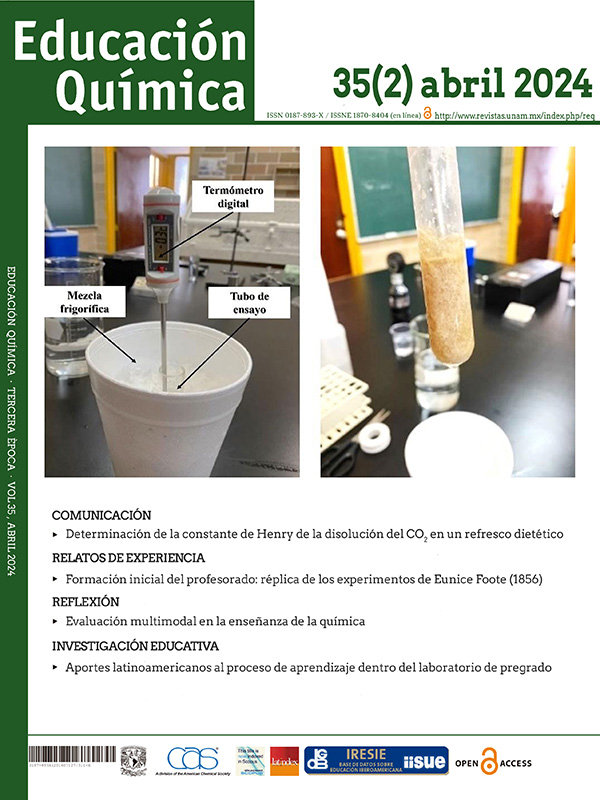Strogens could be an antioxidant alternative
Main Article Content
Abstract
This manuscript presents information about the oxygen reactive species, oxidative stress, and their relationship with many widely distributed/ubiquitous illnesses. The antioxidant activity of estrogens in the organism is discussed along with the main reaction mechanisms involved in this capability. On the other hand, estrogens are endogen molecules of great importance to organisms because they participate in many physiological functions. Here are presented the single electron transfer (SET) reaction mechanism, the radical adduct formation (RAF), and the Hydrogen transfer (HT) of estrogens with the hydroperoxyl radical. The antioxidant activity of estrogens was compared against the ability of other natural antioxidants concluding with the possibility of them to work as antioxidants. The information presented here could be applied as an example in the free radical chapter on the organic chemistry class.
Article Details
Citas en Dimensions Service
References
Avello, M., y Suwalsky, M. (2006a). Radicales libres, antioxidantes naturales y mecanismos de protección. Atenea (Concepción), 494. https://doi.org/10.4067/S0718-04622006000200010
Avello, M., y Suwalsky, M. (2006b). Radicales libres, antioxidantes naturales y mecanismos de protección. Atenea (Concepción), 494. https://doi.org/10.4067/S0718-04622006000200010
Chang, Raymond. et al. (2010). Química (7th ed.).
Dhaunsi, G. S., Gulati, S., Singh, A. K., Orak, J. K., Asayama, K., y Singh, I. (1992). Demonstration of Cu-Zn superoxide dismutase in rat liver peroxisomes. Biochemical and immunochemical evidence. The Journal of Biological Chemistry, 267(10), 6870–6873.
Galano, A., y Alvarez-Idaboy, J. R. (2013). A computational methodology for accurate predictions of rate constants in solution: Application to the assessment of primary antioxidant activity. Journal of Computational Chemistry, 34(28), 2430–2445. https://doi.org/10.1002/jcc.23409
Ghosh, P., Samanta, A. N., y Ray, S. (2010). COD reduction of petrochemical industry wastewater using Fenton’s oxidation. The Canadian Journal of Chemical Engineering, 88(6), 1021–1026. https://doi.org/10.1002/cjce.20353
Halliwell, B., y Gutteridge, J. M. C. (1999). Free Radicals in Biology and Medicine (3ra ed.).
Hernández-Hernández, M. F., Tejeda-Medina, E. A., Espinoza, C., y Medina, M. E. (2023). On the hydroperoxyl radical scavenging activity of estrogens in lipid and aqueous media: a theoretical study. J. Phys. Org. Chem.
Kaipia, A., Toppari, J., Huhtaniemi, I., y Paranko, J. (1994). Sex difference in the action of activin-A on cell proliferation of differentiating rat gonad. Endocrinology, 134(5), 2165–2170. https://doi.org/10.1210/endo.134.5.8156918
Lancaster Jr, J. R. (1992). Nitric oxide in cells. American Scientist, 80(3), 248–259.
Marcos Becerro, J. F. (2008). Las hormonas esteroideas sexuales, el envejecimiento y el ejercicio. Revista Andaluza de Medicina Del Deporte, 1(1), 22–36.
Mayor-Oxilia, R. (2010, December 12). Estrés Oxidativo y Sistema de Defensa Antioxidante. Rev. Inst. Med. Trop., 23–29.
Paredes-Salido, F., y Roca-Fernandez, J. J. (2002). influencia de los radicales libres en el envejecimiento celular. In Bioquímica (7th ed., Vol. 21, pp. 96–100). OFFARM.
Pierce, J. D., Cackler, A. B., y Arnett, M. G. (2004). Why should you care about free radicals? RN, 67(1), 38–42; quiz 43.
Taverne, Y. J., Merkus, D., Bogers, A. J., Halliwell, B., Duncker, D. J., y Lyons, T. W. (2018). Reactive Oxygen Species: Radical Factors in the Evolution of Animal Life. BioEssays, 40(3), 1700158. https://doi.org/10.1002/bies.201700158

Educación Química por Universidad Nacional Autónoma de México se distribuye bajo una Licencia Creative Commons Atribución-NoComercial-SinDerivar 4.0 Internacional.
Basada en una obra en http://www.revistas.unam.mx/index.php/req.
